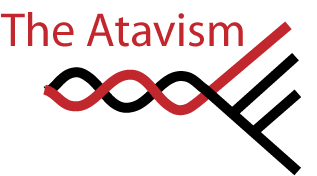Wednesday, February 22, 2012
The Tree of Diversification (or why the March of Progress is wrong)
I'm giving a big talk next week - a departmental seminar. It's the first time I've had more than 15 minutes to talk about my research, so this talk will be a little more discursive that my usual.

I think that when you look at it this way it becomes clear that if we want to understand how the organisms depicted in the most famous icon of evoluton came to be we need to focus not just on how changes occur in one lineage, but on how new lineage form and become capable of changing in their own directions. At the moment there are probably 10 million species on earth, and just how they got to be here is surely one of the biggest questions that biology asks us. Speciation and diversification ought to be central to the way we think about evolution.
I study speciation, how new species come into being, and one of the things that I want to emphasise is that speciation hasn't really entered into the broader understanding of what evolution is.Take the one image that describes evolution in modern society:

The so called "march of progress" has been used to describe the origin of our species thousands upon thousands of times. But it never happened. Only a few of the species depicted are potential ancestors for humans and many of them were contemporaries to each other (as the original diagram makes clear) so can hardly be different steps along a single evolutionary path.

The March of Progress, Rudolph F. Zallinger. From Time Life's book Early Man.
The so called "march of progress" has been used to describe the origin of our species thousands upon thousands of times. But it never happened. Only a few of the species depicted are potential ancestors for humans and many of them were contemporaries to each other (as the original diagram makes clear) so can hardly be different steps along a single evolutionary path.
To try show what really happened, I've redrawn "March of Progress" into the "tree of diversification" - trying to show how the species depicted above relate to each other (parts of this tree are very much up for debate, by the way). Bear in mind, I'm only including the species that are represented in the original graphic, if we were to include all the fossil ape species we know about the tree would be much bushier):

Silhouettes are CC BY-SA by José-Manuel Benitos this image is released under the same license.
I think that when you look at it this way it becomes clear that if we want to understand how the organisms depicted in the most famous icon of evoluton came to be we need to focus not just on how changes occur in one lineage, but on how new lineage form and become capable of changing in their own directions. At the moment there are probably 10 million species on earth, and just how they got to be here is surely one of the biggest questions that biology asks us. Speciation and diversification ought to be central to the way we think about evolution.
Labels: evolution, Human evolution, phylogenetics, sci-blogs, science, science and society
2 Comments:
Great, when's the T shirt coming out
It is interesting to think that all the chronospecies save one are derived from a limited supply of individuals. Our own chronospecies should not really be the last link since it continues to change (at least through random genetic drift where there is absence of evolutionary pressure) I realise that a picture of a dude is easier to make sense of than just some dots, or perhaps some text saying 'watch this space' The thing is that we show many signs of speciation. Even with our ability to overcome geographical obstacles, we still have races, which are thought to be one possible mechanism in speciation. We are the ultimate ring species with many variations, and where geographical obstacles fail, one other obstacle immediately springs to mind, that of culture. Something that the homogenising effect of mass communication has yet failed to completely overcome. It is a topic which is rife with the possibility of misuse. If we are to avoid the topic completely we would lose one of the most rich areas of study in speciation available to us. It is necessary only to remember that any facts about the make up of individuals do not describe that individual as a person. We are all governed far more by instinct than we realise, and yet we all have the power to overcome our genetic programming. No science is racist. I wonder if we think that the study of our own races could be kept non racist?



